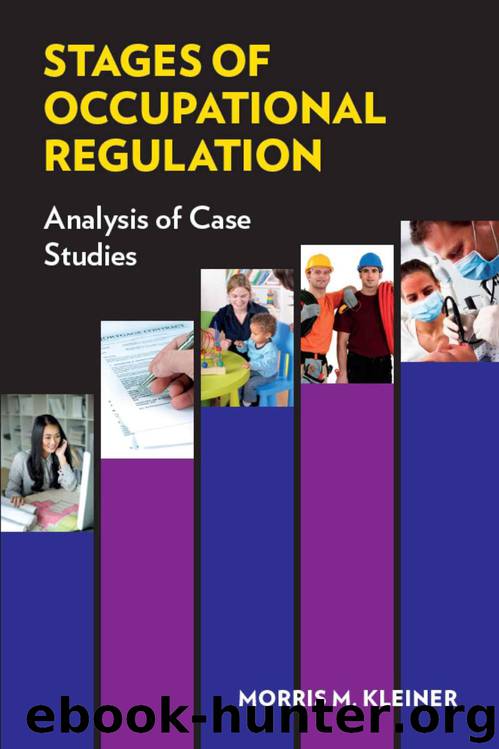Stages of Occupational Regulation: Analysis of Case Studies by Morris Kleiner

Author:Morris Kleiner [Kleiner, Morris]
Language: eng
Format: epub
Publisher: W.E. Upjohn Institute for Employmenbt Research
Published: 0101-01-01T00:00:00+00:00
PUBLIC POLICY APPROACHES TO OCCUPATIONAL
HEALTH AND SAFETY
Public policies on health and safety have generally taken two approaches: the regulation and setting of standards, and the implementation of social insurance through worker compensation. Illustrations of the regulation approach are the passage of the Coal Mine Safety Act in 1969 and the Occupational Safety and Health Act (OSHA) in 1970.
The federal government has played a major role in protecting the health and safety of the workforce. For example, miners have been at the forefront of occupational health and safety legislation, largely because they have the highest rate of injury and death, and also because they have gathered the most attention through the media. Media attention has occurred in part because many of the deaths and injuries involve large groups of miners who are affected in one incident, usually in dramatic fashion. In contrast, deaths and injuries in construction tend to occur to a much greater extent in small groups, away from the spotlight of public attention. The focus on miners develops even though construction workers are likely to have multiple times as many overall deaths and injuries annually. Recent data provided by the Bureau of Labor Statistics show that construction workers have by far the greatest number of deaths and injuries of any industry, and that they rank high in rates of injury and death (BLS 2011). The analysis provided in this chapter adds to the literature on occupational health and safety by examining whether occupational regulation complements current regulatory policies to promote workplace health and safety by reducing the occurrence and severity of occupational injuries. If occupational regulation matters in improving health and safety in this sector, then it could potentially influence other sectors of the economy such as agriculture, mining, or manufacturing, which also have high levels of workplace injuries.
Furthermore, occupational licensing gives a standard method of providing a service to include the health and safety of the workers that are involved in the industry. For example, in the case of electricians, about 10 percent of their class time is spent in discussions of health and safety, and numerous teaching units in apprenticeship programs are explicitly devoted to health and safety (Center for Construction Research and Training 2009); see Box 5.1 for examples of these requirements. The expectation is that workers who have this background on safety from both the classroom and the on-the-job training would incur fewer workplace injuries and deaths. One of the objectives of this chapter is to examine training requirements in more detail with respect to electricians and plumbers, two regulated occupations in the industry.
Electrician Labor Market
Download
This site does not store any files on its server. We only index and link to content provided by other sites. Please contact the content providers to delete copyright contents if any and email us, we'll remove relevant links or contents immediately.
Bullshit Jobs by David Graeber(3831)
Radical Candor by Kim Scott(2579)
I Am Right, You Are Wrong by Edward De Bono(2339)
23:27 by H. L. Roberts(2141)
Nomadland by Jessica Bruder(1959)
Average Is Over by Tyler Cowen(1758)
The Conflict Resolution Phrase Book by Barbara Mitchell & Cornelia Gamlem(1648)
Out of Our Minds: Learning to Be Creative by Ken Robinson(1629)
High-Impact Interview Questions by Victoria A. Hoevemeyer(1611)
The Ideal Team Player by Patrick M. Lencioni(1562)
An Everyone Culture: Becoming a Deliberately Developmental Organization by Robert Kegan & Lisa Laskow Lahey(1527)
The Asshole Survival Guide by Robert I. Sutton(1505)
Automatic Society by Bernard Stiegler(1463)
Who by Street Randy & Smart Geoff(1421)
Unleashed by Anne Morriss & Frances Frei(1421)
Who Moved My Cheese?: An Amazing Way to Deal With Change in Your Work and in Your Life by Johnson Spencer(1417)
42 Rules of Employee Engagement by Susan Stamm(1396)
96 Great Interview Questions to Ask Before You Hire by Paul Falcone(1356)
The Power of Disability by Al Etmanski(1286)
